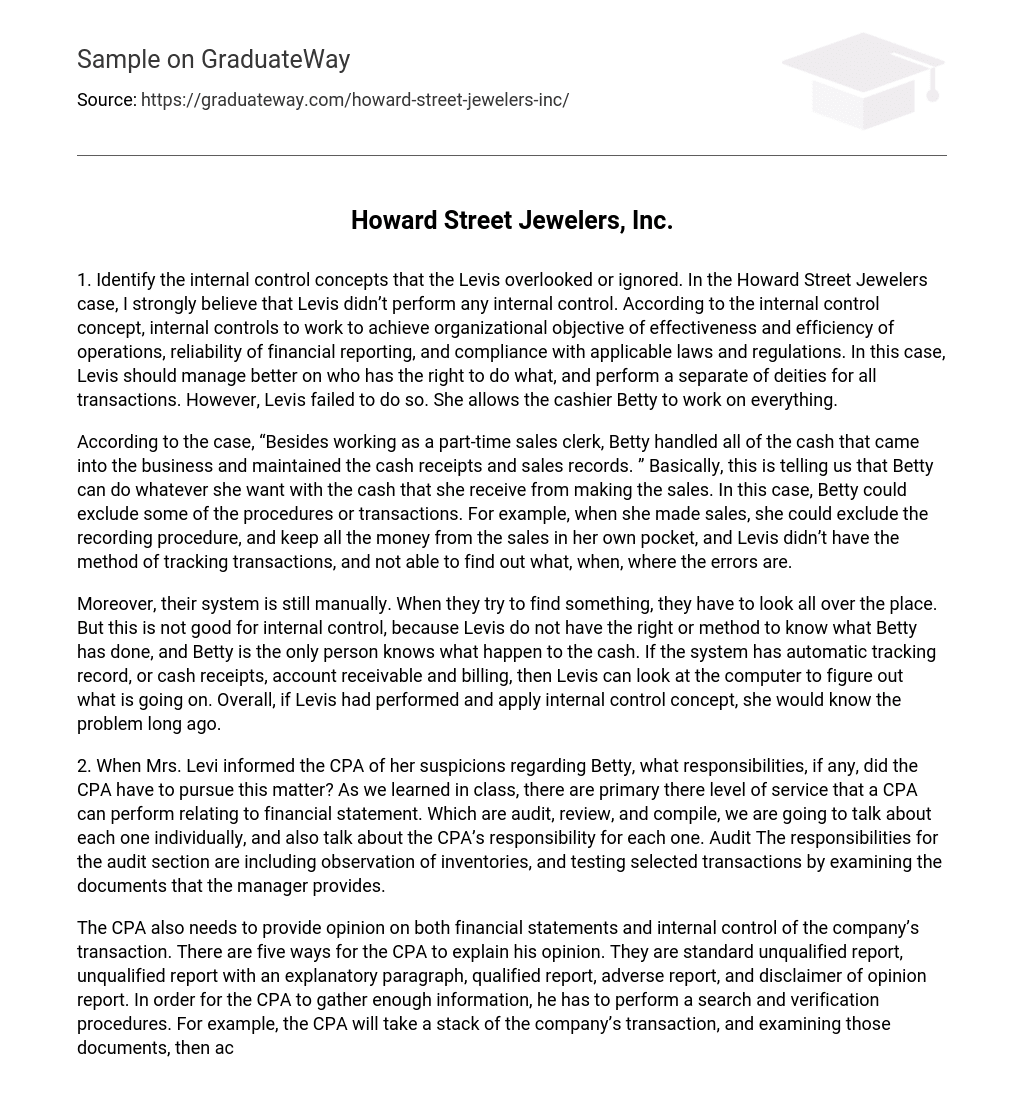1. Identify the internal control concepts that the Levis overlooked or ignored. In the Howard Street Jewelers case, I strongly believe that Levis didn’t perform any internal control. According to the internal control concept, internal controls to work to achieve organizational objective of effectiveness and efficiency of operations, reliability of financial reporting, and compliance with applicable laws and regulations. In this case, Levis should manage better on who has the right to do what, and perform a separate of deities for all transactions. However, Levis failed to do so. She allows the cashier Betty to work on everything.
According to the case, “Besides working as a part-time sales clerk, Betty handled all of the cash that came into the business and maintained the cash receipts and sales records. ” Basically, this is telling us that Betty can do whatever she want with the cash that she receive from making the sales. In this case, Betty could exclude some of the procedures or transactions. For example, when she made sales, she could exclude the recording procedure, and keep all the money from the sales in her own pocket, and Levis didn’t have the method of tracking transactions, and not able to find out what, when, where the errors are.
Moreover, their system is still manually. When they try to find something, they have to look all over the place. But this is not good for internal control, because Levis do not have the right or method to know what Betty has done, and Betty is the only person knows what happen to the cash. If the system has automatic tracking record, or cash receipts, account receivable and billing, then Levis can look at the computer to figure out what is going on. Overall, if Levis had performed and apply internal control concept, she would know the problem long ago.
2. When Mrs. Levi informed the CPA of her suspicions regarding Betty, what responsibilities, if any, did the CPA have to pursue this matter? As we learned in class, there are primary there level of service that a CPA can perform relating to financial statement. Which are audit, review, and compile, we are going to talk about each one individually, and also talk about the CPA’s responsibility for each one. Audit The responsibilities for the audit section are including observation of inventories, and testing selected transactions by examining the documents that the manager provides.
The CPA also needs to provide opinion on both financial statements and internal control of the company’s transaction. There are five ways for the CPA to explain his opinion. They are standard unqualified report, unqualified report with an explanatory paragraph, qualified report, adverse report, and disclaimer of opinion report. In order for the CPA to gather enough information, he has to perform a search and verification procedures. For example, the CPA will take a stack of the company’s transaction, and examining those documents, then accumulating the evidence of how well or how bad the material is present.
In this case, the CPA notice occasional shortages in the cash receipts records that seemed larger than normal for a small retail business, but he didn’t give his opinion to Levis immediately, he didn’t fully fulfill his responsibilities for the audit section. Review The main procedure for the review section is making inquires and performing analytical procedures. The main purpose for the review section is about the fairness of the financial statements.
The CPA’s responsibility for this section is to provide a standard review report, like what the CPA reviewed, what opinion the CPA disclaimed, and what limited assurance the CPA referred. Moreover, the CPA also needs to perform inquired and analytical procedures for each of the items in the financial statement to determine the fairness of it. In this case, the CPA should ask Betty for the general ledger for cash receipt, and items sales regarding to Mrs. Levis’ suspicions, and figure out is there any problem with Betty’s work. Compilation
Compilation doesn’t require making inquires and performing analytical procedure, but it involves presenting the financial statements. If the CPA finds that information may be incorrect or incomplete, then he needs to ask for additional information from the client. Also, the CPA should carefully review and preparing the statements. If there is any obvious mistake, the CPA also needs to responsible for it, because he’s the one who do the job, and his name will be present with the statements too. So the CPA should read carefully, and figure out is the financial statement are follow with GAAP.





